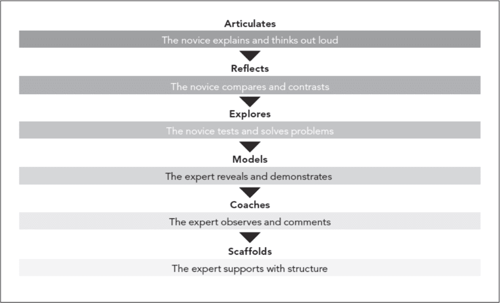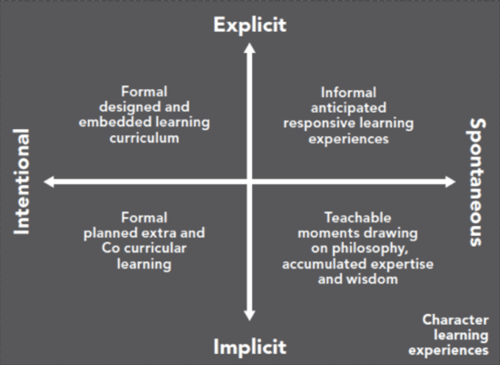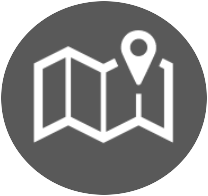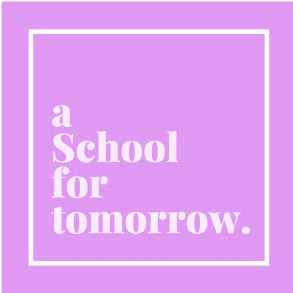Game Changers | Learn | Teaching for Character
Character Learning in Practice
Character education works best when it’s deliberate, targeted and intentional. The consistency and quality of character learning in a school is a reflection of a school’s willingness to embrace character apprenticeships, specific character pedagogies and an approach to strategic educational development that embeds character and competencies into every facet of school life in a deliberate, targeted and intentional way.

CHARACTER APPRENTICESHIP
As educators, we need to develop specific and explicit expertise in shaping character relationships. Many strong and positive relationships (such as the ones referred to above) are formed in which students learn about character through a process of apprenticeship to a variety of experts who can show them how to grow in expertise in character competency. These critical relationships through which so much character learning is enabled can often occur with a reliance on intuition rather than intentionality of practice. We propose that greater attention be given to the nature of intentional relationality within the whole education of a school. This would be based on an understanding that character competency and character leadership are built within special learning relationships that function through a character apprenticeship model based on the cognitive apprenticeship model that responds to explicit and implicit, intentional and spontaneous experiences that grow, test and measure civic, performance and moral character over time within a school, its culture, and its community.

Our Model for Character Apprenticeship (shown above) progresses from articulation to reflection to exploration as a novice, then from modelling to coaching to scaffolding as an expert. It is a strong yet non-judgmental way of explaining how a student learns about character in relationship with others. It emphasises the importance of teaching and leading others towards mastery of character competency as a feature of character education itself. In other words, there must be a deliberate pedagogical shift in the power dynamic of the learning relationship as the expert hands over the opportunity to teach others to those who were once their novices and are now experts in their own right. The movement from novice to expert is not necessarily linear, nor does it preclude a learner being both simultaneously: many supposed experts still regard themselves as being learners who are also benefitting from being in relationship with those whom they consider to be greater experts. What is critical in this is the shift in power over time from the expert to the novice: it is passed on in the same way as the expertise is passed on.
The consistency and quality of character learning in a school is a reflection of a school’s willingness to embrace character apprenticeships, specific character pedagogies and an approach to strategic educational development that embeds character and competencies into every facet of school life in a deliberate, targeted and intentional way.
THE PEDAGOGIES OF AN EDUCATION FOR CHARACTER AND COMPETENCY
The attainment of desired graduate outcomes based on civic, performance and moral character and competencies in a school depends critically on the nature of the specific pedagogical relationships of character apprenticeships in which students are accepted as novices, craft their character competencies, acquire expertise, and pass this on in turn to others. How we do this, on a daily basis, with our students and with each other, in no small measure determines the success of what we do. Much of this will be reflected in our pedagogies. From what we have seen in our study and more broadly, we feel that the Character Learning Experiences created by our pedagogies can best be situated within a quadrant formed by two axes that stretch from ‘Explicit Learning’ to ‘Implicit Learning’ and from ‘Intentional Learning’ to ‘Spontaneous Learning’ (see diagram below).

This allows us to identify four types of learning experience:
- Explicit and intentional pedagogy: Formal designed and embedded learning curriculum can be seen in the deliberately constructed units of learning that consciously integrate character into the classroom and are usually the subject of formal formative and/or summative assessment programs.
- Implicit and intentional pedagogy: Formal planned co-curricular and extra-curricular learning may also lead to specific deliberately planned character education. The shape of this learning is often drawn out within an experiential mode and its assessment can usually be distinguished by its performative or competitive environment rather an academic one.
- Explicit and spontaneous pedagogy: Informal anticipated responsive learning experiences see teachers prepare for moments that might reasonably be anticipated in the normal course of events. These can be seen in the conversations about academic misconduct, personal integrity, the need to work hard and so on, that teachers visit with cohorts in a predictable fashion. They know they will happen and so they develop responses in advance so that when the time comes, they are ready to engage students in the matter at hand equipped with the confidence of a pre-prepared position and sometimes even resources to support them.
- Implicit and spontaneous pedagogy: Teachable moments drawing on philosophy and accumulated expertise and wisdom arise when teachers and students find themselves placed in a context in which matters of character arise perhaps less predictably. Teachers use their experience and accumulated wisdom to construct learning experiences ex tempore to meet the needs of the moment.
Currently, many primary or elementary educators tend to emphasise explicit pedagogies while senior school educators tend to emphasise implicit pedagogies. Most educators default to one of these approaches. We believe that all educators need to become expert in the pedagogy and curriculum of all four types of learning experience. From what we have seen internationally, we are led to the conclusion, in fact, that this body of pedagogical knowledge and its corresponding understanding level of effectiveness in character education, while complex in so many ways, is identifiable and discussable – and certainly so if and when the right conditions and direction for professional discussion and growth are set in place. In its current state in schools, there is a hidden and tacit world of professional knowledge in character education that needs to be made explicit and made better for all in the process.
A STRATEGIC APPROACH TO A FRAMEWORK FOR EDUCATION
An agreed and documented framework for education helps a school to gather evidence about, align, and implement, and evaluate its shared educational vision within a community of inquiry and practice dedicated to achieving its graduate outcomes:
- Preamble: The rationale for education at the school linked to the school’s understanding of its traditions and history, culture, mission and aspirations for 21C learning and society, especially with respect to the civic, performance, and moral character development of its students.
- Graduate Profile: A description of the desirable qualities and character competencies of a graduate linked to school values, mission and ethos.
- Teaching Objectives: Specific integrated knowledge, skills and character outcomes to be covered across the curriculum, co-curriculum and other educational and care structures of the school.
- Learning Experiences and Outcomes: Specific character education learning experiences and outcomes that students will experience in learning units and programs delivered by faculties, departments and other educational and care teams in the school.
- Exemplars of Outstanding Practice/School Pedagogy: A collation of excellent practice undertaken in education at the school that is shaped into an illustrative guide to teaching and learning practice (pedagogy) at the school and a corresponding set of guiding philosophies, design principles and learning intentions.
- Staff Profile and Outcomes: A description of the qualities and competencies of a school staff member that are necessary to deliver the values, ethos and mission of the school, especially with relation to character education.
- Staff Professional Learning and Student Training and Development Program: A comprehensive, staged plan for identifying and improving the competencies of staff and students in character education and character leadership.
- Community Engagement Plan: A plan to engage the community in the educational work of the school that includes a work in progress (WIP) schedule of regular community engagement activity as well as specific plans for special events and campaigns related to character education.
One way of looking at the process as a whole is to define its concrete phases and map them to a timeline over 3-5 years:
- Conduct an audit and report out on findings and recommendations;
- Form a Strategic Education Team and develop Graduate Profile;
- Develop a draft Framework for Education; 4. Conduct pilot programs and projects;
- Refine and complete the Framework for Education;
- Implement in stages and progressively evaluate.
What might be the goals, associated outcomes, and processes of a project that seeks to develop and implement a Framework for Education?
- Learn: The school should cultivate the development of a deliberate, targeted and intentional learning culture to embed this understanding of character and competencies across the curriculum, co-curriculum, and extra-curriculum. Senior leaders in the school will typically embed the framework at a whole school level and will support the work of the Strategic Education Team by facilitating and resourcing whole-school processes such as curriculum design and implementation, student assessment and reporting, staff professional learning and release time, ongoing internal communications, and (perhaps most importantly) a timetable that allows staff to meet regularly to collaborate on their work in character education. Middle leaders comprising departmental and activity leaders as well as other expert practitioners embed the framework in the work of their existing staff teams and support the work of the Strategic Education Team by developing and implementing aligned approaches to character education that are germane to their fields of learning.
- Live: The school should foster a culture that nurtures and inspires 21C character and competency through the infusion across all aspects of school life of enduring values and honourable tradition on the one hand, and research, innovation and future readiness on the other. Centres for learning and innovation can create energy and push boundaries – using centres for character learning to build culture and reputation, train staff brand champions and ambassadors, and develop hotspots of practitioner expertise through pilot programs and master-classes in character pedagogy, pastoral practice, as well as building partnerships that promote initiative, entrepreneurial thinking and innovation.
- Lead: The school should embed a leadership culture that encourages the aspirations, voices, and lived experiences of the students of the school and prepares them to thrive in their world with 21C character and competency. The school should encourage processes in which students test and validate the framework through their leadership and learning – using existing and new student leadership groups to create a coordinated student voice program to promote authentic student experiences of character learning, especially through leadership, service, publishing, and advocacy. The school needs to develop a shared understanding of the strategic imperative for student care and learning that is situated in the context of the best thinking about 21C character and competencies. Community engagement led by the Principal helps the community understand the framework and talk it up appropriately. It will engage the support of the school’s respected stewards in creating and authorising ongoing programs of community engagement to build a marketplace of ideas, conversation, and support for the shared aspirations and language of the school’s Framework for Education.
- Work: The school should prioritise student, teacher, and leadership practice that most warrants support in effecting high performance delivery of character and competencies. Using an internal evaluation team to collaborate with staff to design and implement positive, effective and efficient staff evaluation, program review and performance development systems will enable a school to identify, reward, and resource what is really working well to further its character education goals in the daily practice of the school. The school should promote the collaborative design and delivery of those educational practices, pathways, programs and pedagogies that most support development and mastery in character and competencies.
The purpose of a School for tomorrow is to prepare our students to thrive in their world. How we educate for character and competency is the core business of this; it is the whole work of a school and the work of a whole school.






